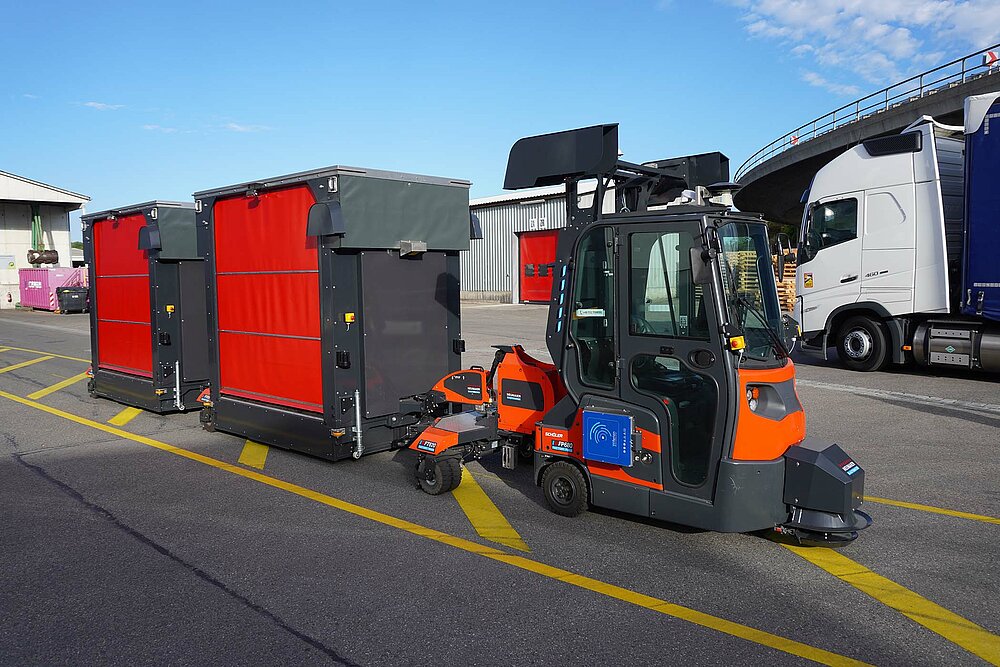
Roto intralojistiği için bir sunum projesi
Otomasyon ve dijitalleşme: Leinfelden-Echterdingen'deki Roto fabrikasında otonom bir açık hava nakliye treni / Ara depolama alanında tam otomatik yükleme ve Lojistik Hizmet Merkezinde boşaltma / Ara depolama alanında tam otomatik yükleme ve Lojistik Hizmet Merkezinde boşaltma/Üretim ve intralojistikte çok yüksek derecede otomasyon / Yoğun planlama aşaması / Çok seviyeli emniyet konsepti
Leinfelden-Echterdingen – Üretimde otomasyon, şirket ve müşterileri için her zaman somut iyileştirmeler sağlamalıdır. Roto Frank Fenster- und Türtechnologie GmbH, Leinfelden-Echterdingen üretim tesisinde tamamlanan başka bir projenin bu kriterleri nasıl karşıladığının ayrıntılarını paylaşıyor. Bu yılın Ekim ayından bu yana, tüm üretim çıktısı, tam otomatik, elektrikli, sürücüsüz bir dış mekan nakliye treni sayesinde şirketin tesislerinde üretimdeki geçici depolama alanından taşındı. Tren ayrıca taşınan paletleri Lojistik Hizmet Merkezi'nde tam otomatik olarak boşaltır. Yükleme, boşaltma ve taşıma, manuel müdahale olmadan otonom olarak gerçekleştirilir.
Read more
By using this outdoor transport train, the global architectural hardware and gasket specialist is once again living up to its reputation as a pioneer in the use of innovative technologies in the architectural hardware industry. It has also sparked great interest from industrial companies outside the sector in Stuttgart, who have already seen the system in use at Roto.
Optimal organisation of material flows
The project forms part of the “Logistics Strategy 2025” adopted by Roto Fenster- und Türtechnologie GmbH in 2019. This strategy involved defining several concepts with a focus on automation and digitalisation. As a result, since the end of 2020, driverless transport systems have been supplying the indoor production facility at the site with empty cardboard boxes and transporting the full boxes from the assembly lines to the interim storage area. Stefan Duge, Intralogistics Project Manager in Leinfelden, summarises the benefits of both transport systems: “Now this project has been completed, it has enabled us to optimise the organisation of a large part of our internal material flows. Both transport systems are extremely flexible and ensure continuous material flows within our production and intralogistics.”
Faster availability for customers
The added value for customers is clear from the faster availability of goods. Duge describes the connections: “Both systems can be used irrespective of the number of work shifts. This means that we reduce our throughput times by continuing to transport parts and materials 24/7 without interruption, even at peak production capacity or during holiday periods. As a result, our finished goods are dispatched more quickly and are therefore also available to our customers sooner.”
With regard to delivery performance, there are further advantages which are to be expected to a certain extent for an indoor system, but which are remarkable for an outdoor system. With just one annual inspection, the outdoor transport train is likely to require little maintenance; it is ready for use in almost all weather conditions and can, of course, also be controlled manually, if required.
Reliable safety
The outdoor transport train was commissioned following intensive planning with the support of the supplier Neumaier Industry GmbH & Co. This planning phase involved determining the quantities to be transported, the exact specifications of the vehicle, the technical and visual design of the transfer stations and the multi-level safety concept. Both the tractor unit and the two trailers are equipped with all-round safety scanners. These can detect the smallest obstacles – or even a person on the track or between the three train sections – and stop the vehicle immediately.
The illuminated transport train moves at a maximum speed of 5 km/h across the plant premises. It is equipped with geonavigation in order to stay exactly on the specified route. Road markings, signs and speed bollards guide and “slow down” any lorry traffic which is also on the company premises at the same time, so that the vehicles do not obstruct each other.
Roller conveyor technology
The communication between the transport systems was also precisely coordinated, as the outdoor transport train collects the finished goods from the interim storage area, i.e. from the same hall in which several manually controlled indoor transport systems and the autonomous indoor transport train are also moving. Loading and unloading operations use the same powered roller conveyor technology which has also proven itself in the industry for buffering pallets. Accordingly, the two trailers of the outdoor transport train are also equipped with roller conveyors and each trailer can hold two pallets per transport.
Automation and digitalisation variety
The outdoor transport train is another example of the logistics strategy being implemented consistently and therefore further demonstrates the company’s drive for full automation and digitalisation. Although the system cannot be used 1:1 at other locations, Production Director Dr Stefan Thiemermann says Roto wants to “transfer the experience from this project to other production plants in the medium term”.
There is a long list of Industry 4.0 projects already in progress including recording machine and operating data online, using collaborative robots, digital spare parts management, 3D printing (additive manufacturing) and using mixed reality glasses (HoloLens). Thiemermann summarises the aim of all these projects and the benefits for the customer: “Automation and digitalisation are key pillars in our strategy of operational excellence which also help us to provide our customers with the best quality and ensure a reliable delivery service.”


